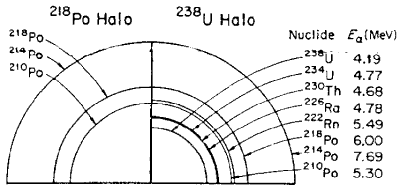 |
Science Frontiers ONLINE No. 58: Jul-Aug 1988 |
|
|
Gentry's tiny mystery-- unsupported by geology
An article bearing the above title, by J. Richard Wakefield, appeared in the Winter 1987-1988 issue of Creation/Evolution. The title implies that Gentry's "Tiny Mystery" is soon to be demolished. It turns out in the end that a sweeping interpretation of this "Tiny Mystery" is called into question, but the mystery itself, like the smile on the Cheshire cat, remains.
The "Tiny Mystery" is the existence of radiohalos from polonium-210, -214, and -218 in some biotites (micas), sans any detectable precursory uranium or halos thereof. Since the half-lives of the polonium isotopes are 138.4 days, 0.000164 second, and 3.04 minutes, respectively, it is certainly perplexing how the polonium halos got where they are! According to geological thinking, the igneous rocks containing the biotites must have been molten for a good deal longer than 138 days, thus destroying halos of short-lived isotopes.
R.V. Gentry, a creationist, thinks that the polonium isotopes are primordial -- created by God some 6,000 years ago, in situ and without precursors. The rocks displaying the halos would, therefore, be among the oldest rocks on earth. What Wakefield does is exxamine the geology of some of the sites from which Gentry obtained his biotite samples. Basically, he finds that the supposedly primordial rocks are often just dikes and veins that were formed much later than the earth's oldest rocks. Wakefield comments, "This fact alone tells us that the rocks bearing Gentry's halos, even if instantly created, have no bearing on the origin and age of the earth."
But does Gentry's "Tiny Mystery" vanish? Not at all -- unlike the Cheshire cat's grin. The polonium halos, seem ingly without detectable precursors, are still there. Wakefield states with all honesty, "Still, we must give Gentry his due. Nothing in geology fully explains the apparent occurrence of the polonium halos as described by Gentry. They do remain a minor mystery in the field of physics." Someone may eventually find an explanation in terms of quirkish chemical deposition or misidentification of the halos, but for now the "Tiny Mystery" survives!
(Wakefield, J. Richard; "Gentry's Tiny Mystery -- Unsupported by Geology," Creation/Evolution, 22:13, Winter 19871988.)
Reference. There are many anomalous radiohalos. See ESP1 in our catalog: Anomalies in Geology, which is described here.
 | (Right): Normal halo complex associated with the decay of uranium-238. (Left) Polonium halos without precursors. |